SOC308 - Sociology: Community, Social Structures and Online Influence
VerifiedAdded on 2023/05/27
|7
|1612
|238
Essay
AI Summary
This essay provides a sociological analysis of the concept of "community," exploring its various definitions and theoretical underpinnings. It discusses how sociologists understand community as a social construct shaped by human behaviors, interactions, shared values, and expectations. The essay also examines the influence of online communities on this conceptualization, highlighting the differences between online and physical communities, particularly in the structure of social ties. Furthermore, it explores different forms of communities, from traditional rural villages to modern virtual communities, and emphasizes the evolving nature of community in the contemporary world, where the need to belong and connect with others remains a central theme. Desklib offers a platform to explore similar essays and study resources.

Running head: SOCIOLOGY AND SOCIAL SCIENCE
SOCIOLOGY AND SOCIAL SCIENCE
Name of the Student:
Name of the University:
Author note:
SOCIOLOGY AND SOCIAL SCIENCE
Name of the Student:
Name of the University:
Author note:
Paraphrase This Document
Need a fresh take? Get an instant paraphrase of this document with our AI Paraphraser
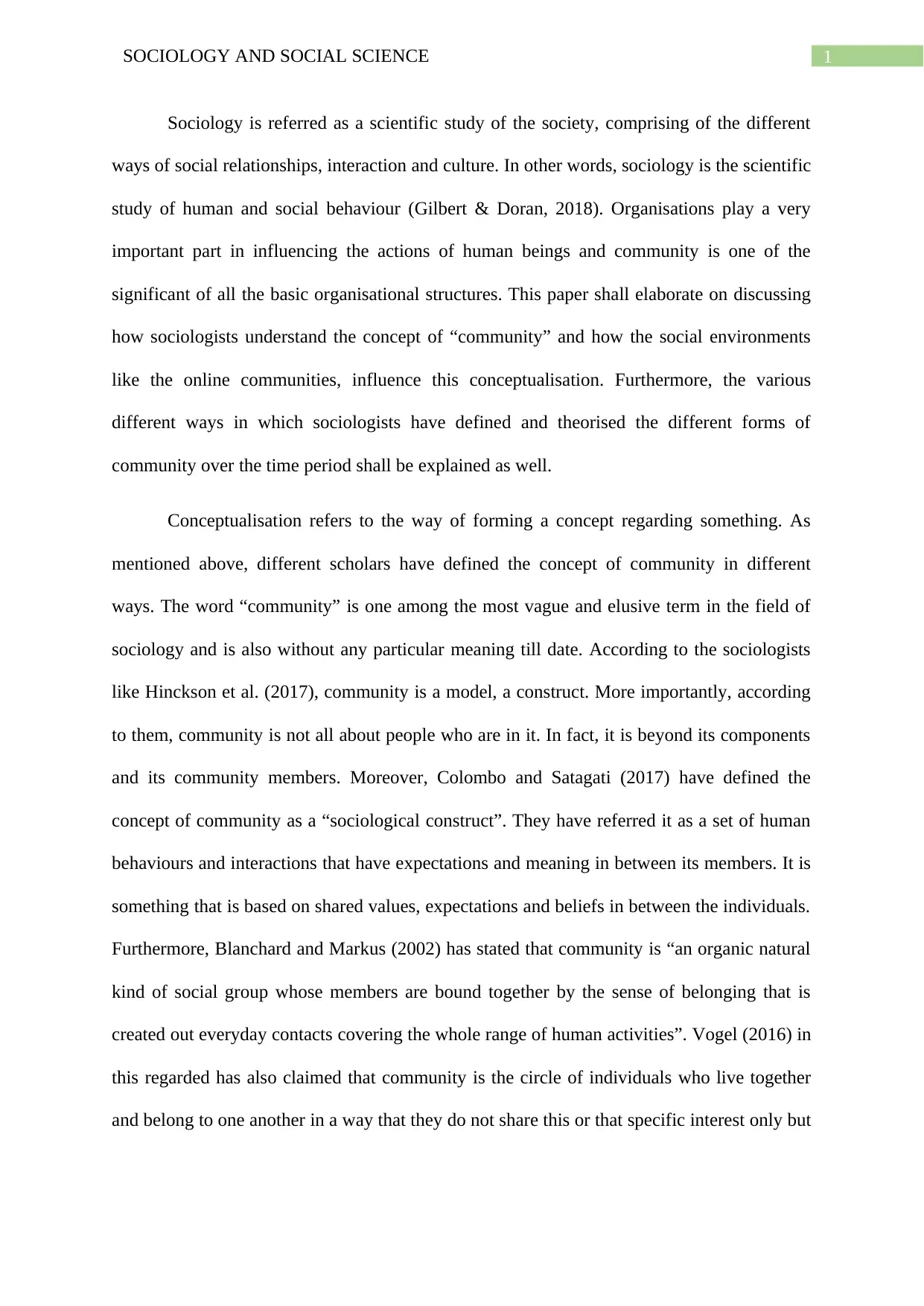
1SOCIOLOGY AND SOCIAL SCIENCE
Sociology is referred as a scientific study of the society, comprising of the different
ways of social relationships, interaction and culture. In other words, sociology is the scientific
study of human and social behaviour (Gilbert & Doran, 2018). Organisations play a very
important part in influencing the actions of human beings and community is one of the
significant of all the basic organisational structures. This paper shall elaborate on discussing
how sociologists understand the concept of “community” and how the social environments
like the online communities, influence this conceptualisation. Furthermore, the various
different ways in which sociologists have defined and theorised the different forms of
community over the time period shall be explained as well.
Conceptualisation refers to the way of forming a concept regarding something. As
mentioned above, different scholars have defined the concept of community in different
ways. The word “community” is one among the most vague and elusive term in the field of
sociology and is also without any particular meaning till date. According to the sociologists
like Hinckson et al. (2017), community is a model, a construct. More importantly, according
to them, community is not all about people who are in it. In fact, it is beyond its components
and its community members. Moreover, Colombo and Satagati (2017) have defined the
concept of community as a “sociological construct”. They have referred it as a set of human
behaviours and interactions that have expectations and meaning in between its members. It is
something that is based on shared values, expectations and beliefs in between the individuals.
Furthermore, Blanchard and Markus (2002) has stated that community is “an organic natural
kind of social group whose members are bound together by the sense of belonging that is
created out everyday contacts covering the whole range of human activities”. Vogel (2016) in
this regarded has also claimed that community is the circle of individuals who live together
and belong to one another in a way that they do not share this or that specific interest only but
Sociology is referred as a scientific study of the society, comprising of the different
ways of social relationships, interaction and culture. In other words, sociology is the scientific
study of human and social behaviour (Gilbert & Doran, 2018). Organisations play a very
important part in influencing the actions of human beings and community is one of the
significant of all the basic organisational structures. This paper shall elaborate on discussing
how sociologists understand the concept of “community” and how the social environments
like the online communities, influence this conceptualisation. Furthermore, the various
different ways in which sociologists have defined and theorised the different forms of
community over the time period shall be explained as well.
Conceptualisation refers to the way of forming a concept regarding something. As
mentioned above, different scholars have defined the concept of community in different
ways. The word “community” is one among the most vague and elusive term in the field of
sociology and is also without any particular meaning till date. According to the sociologists
like Hinckson et al. (2017), community is a model, a construct. More importantly, according
to them, community is not all about people who are in it. In fact, it is beyond its components
and its community members. Moreover, Colombo and Satagati (2017) have defined the
concept of community as a “sociological construct”. They have referred it as a set of human
behaviours and interactions that have expectations and meaning in between its members. It is
something that is based on shared values, expectations and beliefs in between the individuals.
Furthermore, Blanchard and Markus (2002) has stated that community is “an organic natural
kind of social group whose members are bound together by the sense of belonging that is
created out everyday contacts covering the whole range of human activities”. Vogel (2016) in
this regarded has also claimed that community is the circle of individuals who live together
and belong to one another in a way that they do not share this or that specific interest only but
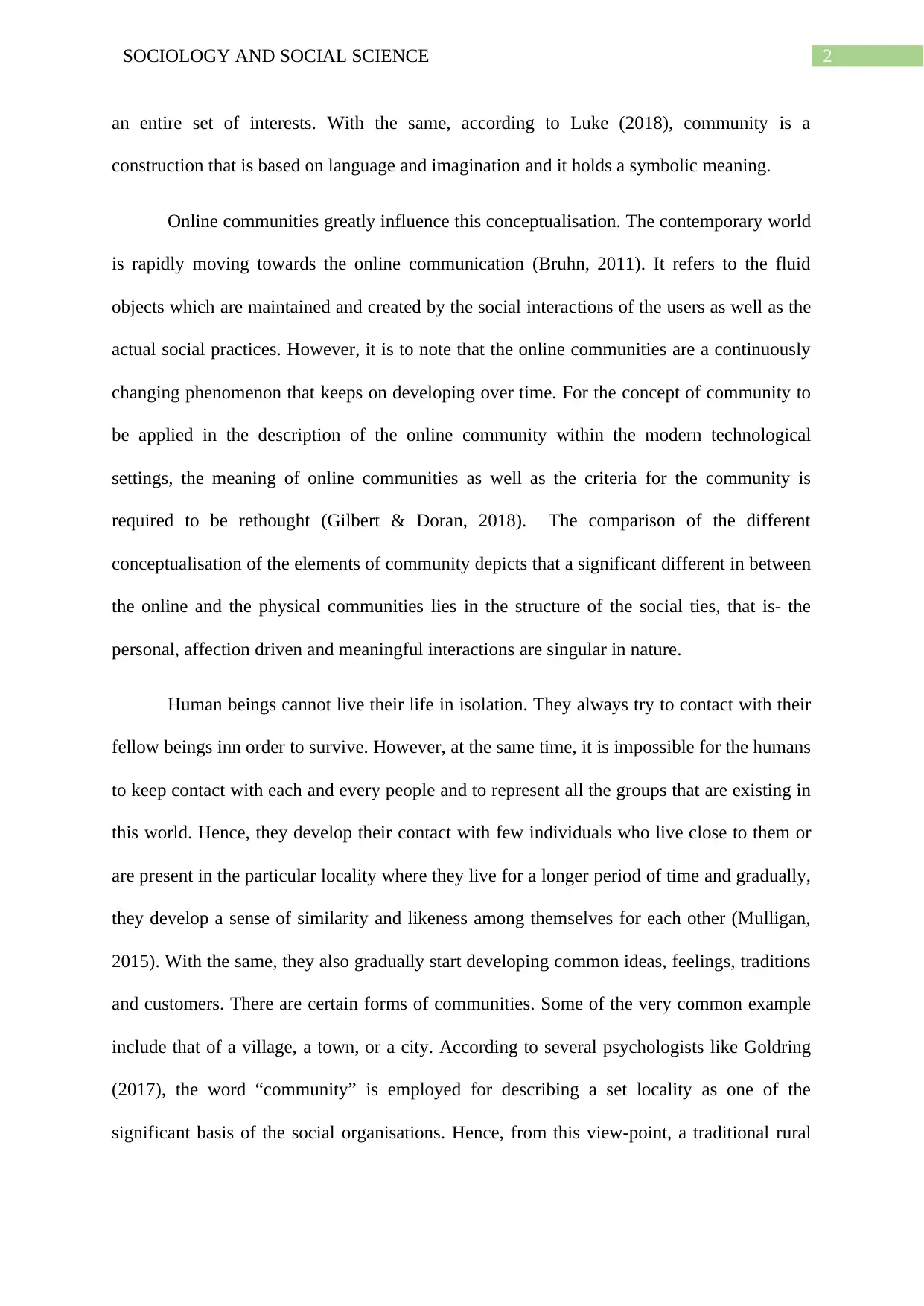
2SOCIOLOGY AND SOCIAL SCIENCE
an entire set of interests. With the same, according to Luke (2018), community is a
construction that is based on language and imagination and it holds a symbolic meaning.
Online communities greatly influence this conceptualisation. The contemporary world
is rapidly moving towards the online communication (Bruhn, 2011). It refers to the fluid
objects which are maintained and created by the social interactions of the users as well as the
actual social practices. However, it is to note that the online communities are a continuously
changing phenomenon that keeps on developing over time. For the concept of community to
be applied in the description of the online community within the modern technological
settings, the meaning of online communities as well as the criteria for the community is
required to be rethought (Gilbert & Doran, 2018). The comparison of the different
conceptualisation of the elements of community depicts that a significant different in between
the online and the physical communities lies in the structure of the social ties, that is- the
personal, affection driven and meaningful interactions are singular in nature.
Human beings cannot live their life in isolation. They always try to contact with their
fellow beings inn order to survive. However, at the same time, it is impossible for the humans
to keep contact with each and every people and to represent all the groups that are existing in
this world. Hence, they develop their contact with few individuals who live close to them or
are present in the particular locality where they live for a longer period of time and gradually,
they develop a sense of similarity and likeness among themselves for each other (Mulligan,
2015). With the same, they also gradually start developing common ideas, feelings, traditions
and customers. There are certain forms of communities. Some of the very common example
include that of a village, a town, or a city. According to several psychologists like Goldring
(2017), the word “community” is employed for describing a set locality as one of the
significant basis of the social organisations. Hence, from this view-point, a traditional rural
an entire set of interests. With the same, according to Luke (2018), community is a
construction that is based on language and imagination and it holds a symbolic meaning.
Online communities greatly influence this conceptualisation. The contemporary world
is rapidly moving towards the online communication (Bruhn, 2011). It refers to the fluid
objects which are maintained and created by the social interactions of the users as well as the
actual social practices. However, it is to note that the online communities are a continuously
changing phenomenon that keeps on developing over time. For the concept of community to
be applied in the description of the online community within the modern technological
settings, the meaning of online communities as well as the criteria for the community is
required to be rethought (Gilbert & Doran, 2018). The comparison of the different
conceptualisation of the elements of community depicts that a significant different in between
the online and the physical communities lies in the structure of the social ties, that is- the
personal, affection driven and meaningful interactions are singular in nature.
Human beings cannot live their life in isolation. They always try to contact with their
fellow beings inn order to survive. However, at the same time, it is impossible for the humans
to keep contact with each and every people and to represent all the groups that are existing in
this world. Hence, they develop their contact with few individuals who live close to them or
are present in the particular locality where they live for a longer period of time and gradually,
they develop a sense of similarity and likeness among themselves for each other (Mulligan,
2015). With the same, they also gradually start developing common ideas, feelings, traditions
and customers. There are certain forms of communities. Some of the very common example
include that of a village, a town, or a city. According to several psychologists like Goldring
(2017), the word “community” is employed for describing a set locality as one of the
significant basis of the social organisations. Hence, from this view-point, a traditional rural
⊘ This is a preview!⊘
Do you want full access?
Subscribe today to unlock all pages.

Trusted by 1+ million students worldwide
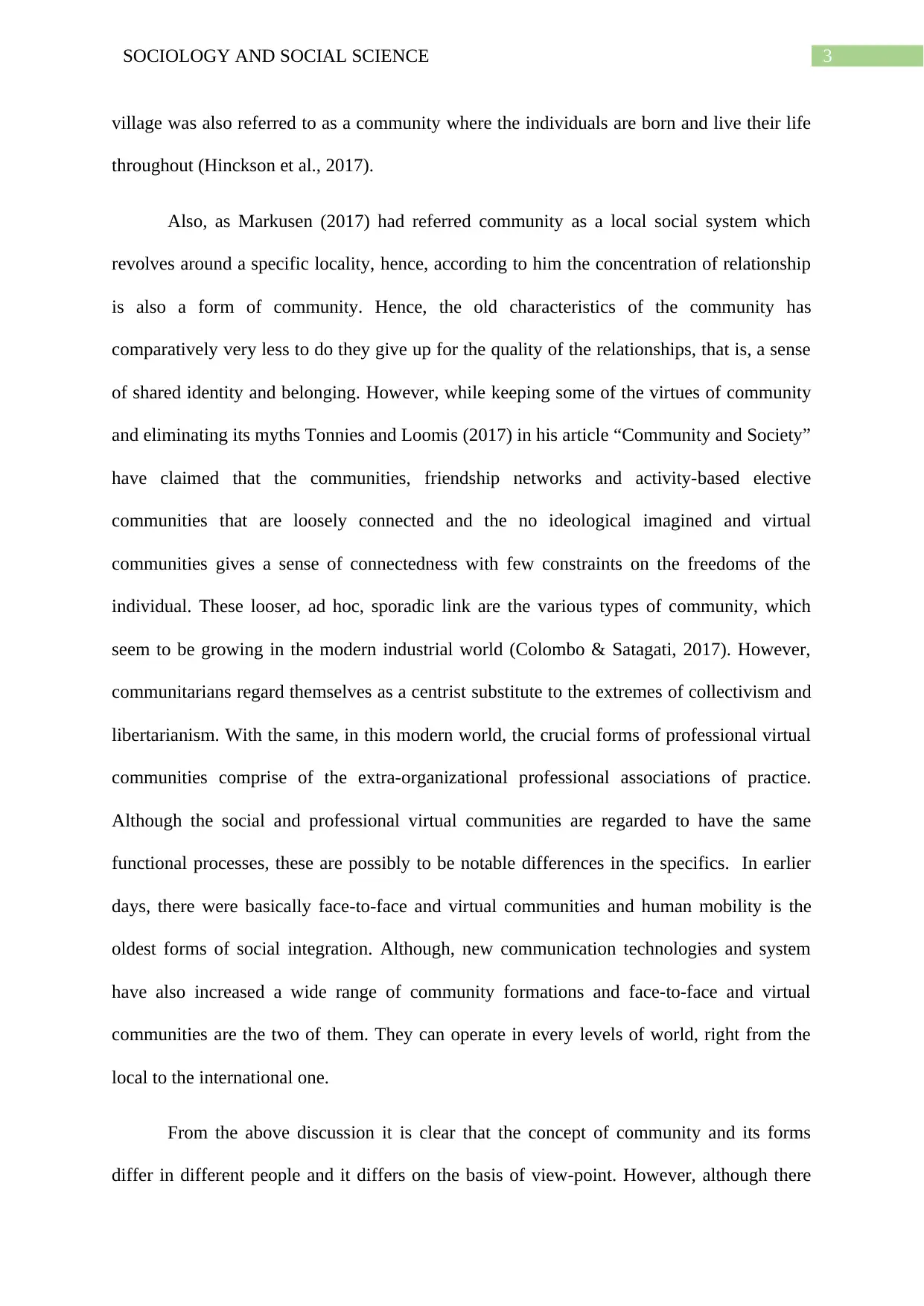
3SOCIOLOGY AND SOCIAL SCIENCE
village was also referred to as a community where the individuals are born and live their life
throughout (Hinckson et al., 2017).
Also, as Markusen (2017) had referred community as a local social system which
revolves around a specific locality, hence, according to him the concentration of relationship
is also a form of community. Hence, the old characteristics of the community has
comparatively very less to do they give up for the quality of the relationships, that is, a sense
of shared identity and belonging. However, while keeping some of the virtues of community
and eliminating its myths Tonnies and Loomis (2017) in his article “Community and Society”
have claimed that the communities, friendship networks and activity-based elective
communities that are loosely connected and the no ideological imagined and virtual
communities gives a sense of connectedness with few constraints on the freedoms of the
individual. These looser, ad hoc, sporadic link are the various types of community, which
seem to be growing in the modern industrial world (Colombo & Satagati, 2017). However,
communitarians regard themselves as a centrist substitute to the extremes of collectivism and
libertarianism. With the same, in this modern world, the crucial forms of professional virtual
communities comprise of the extra-organizational professional associations of practice.
Although the social and professional virtual communities are regarded to have the same
functional processes, these are possibly to be notable differences in the specifics. In earlier
days, there were basically face-to-face and virtual communities and human mobility is the
oldest forms of social integration. Although, new communication technologies and system
have also increased a wide range of community formations and face-to-face and virtual
communities are the two of them. They can operate in every levels of world, right from the
local to the international one.
From the above discussion it is clear that the concept of community and its forms
differ in different people and it differs on the basis of view-point. However, although there
village was also referred to as a community where the individuals are born and live their life
throughout (Hinckson et al., 2017).
Also, as Markusen (2017) had referred community as a local social system which
revolves around a specific locality, hence, according to him the concentration of relationship
is also a form of community. Hence, the old characteristics of the community has
comparatively very less to do they give up for the quality of the relationships, that is, a sense
of shared identity and belonging. However, while keeping some of the virtues of community
and eliminating its myths Tonnies and Loomis (2017) in his article “Community and Society”
have claimed that the communities, friendship networks and activity-based elective
communities that are loosely connected and the no ideological imagined and virtual
communities gives a sense of connectedness with few constraints on the freedoms of the
individual. These looser, ad hoc, sporadic link are the various types of community, which
seem to be growing in the modern industrial world (Colombo & Satagati, 2017). However,
communitarians regard themselves as a centrist substitute to the extremes of collectivism and
libertarianism. With the same, in this modern world, the crucial forms of professional virtual
communities comprise of the extra-organizational professional associations of practice.
Although the social and professional virtual communities are regarded to have the same
functional processes, these are possibly to be notable differences in the specifics. In earlier
days, there were basically face-to-face and virtual communities and human mobility is the
oldest forms of social integration. Although, new communication technologies and system
have also increased a wide range of community formations and face-to-face and virtual
communities are the two of them. They can operate in every levels of world, right from the
local to the international one.
From the above discussion it is clear that the concept of community and its forms
differ in different people and it differs on the basis of view-point. However, although there
Paraphrase This Document
Need a fresh take? Get an instant paraphrase of this document with our AI Paraphraser
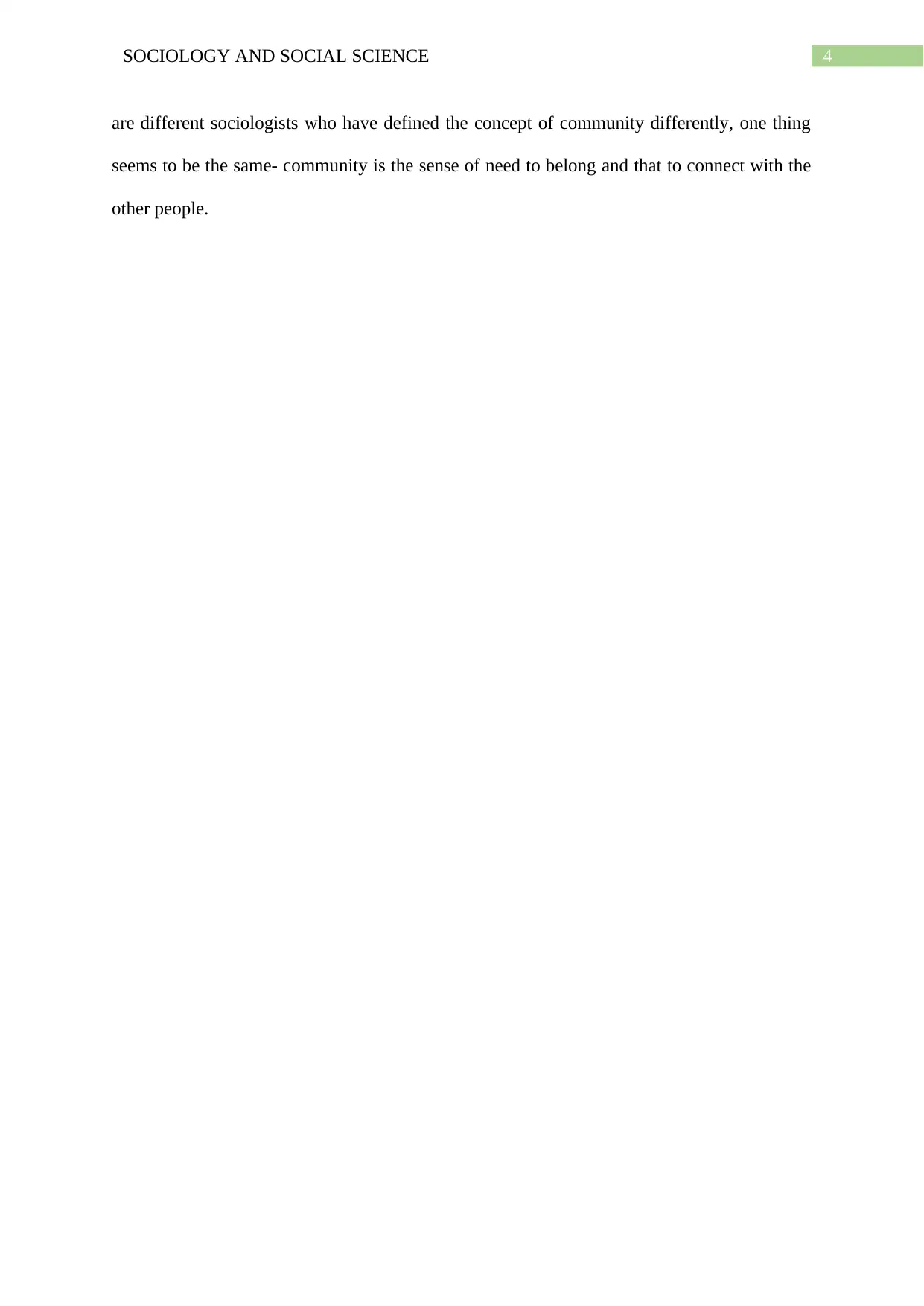
4SOCIOLOGY AND SOCIAL SCIENCE
are different sociologists who have defined the concept of community differently, one thing
seems to be the same- community is the sense of need to belong and that to connect with the
other people.
are different sociologists who have defined the concept of community differently, one thing
seems to be the same- community is the sense of need to belong and that to connect with the
other people.
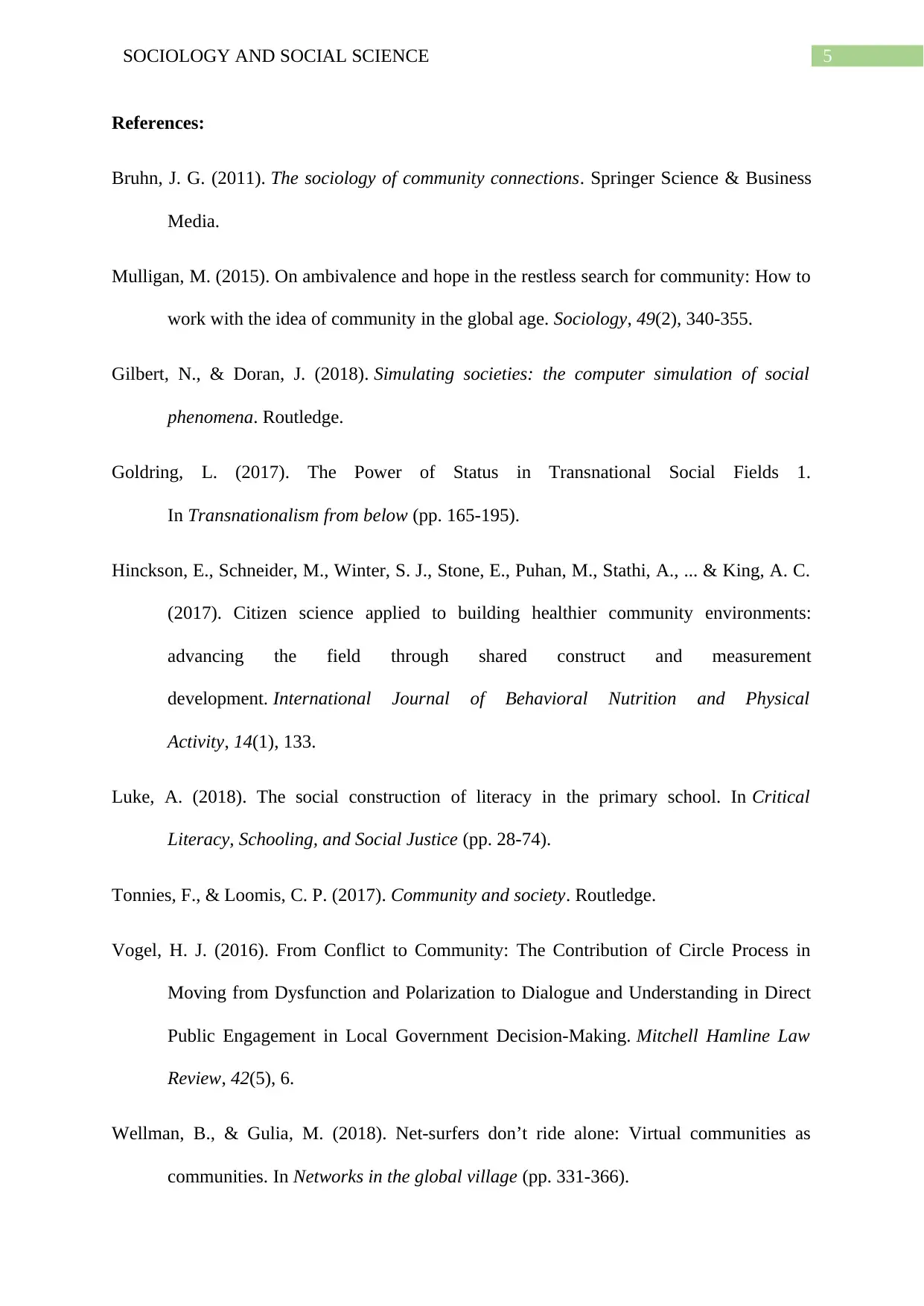
5SOCIOLOGY AND SOCIAL SCIENCE
References:
Bruhn, J. G. (2011). The sociology of community connections. Springer Science & Business
Media.
Mulligan, M. (2015). On ambivalence and hope in the restless search for community: How to
work with the idea of community in the global age. Sociology, 49(2), 340-355.
Gilbert, N., & Doran, J. (2018). Simulating societies: the computer simulation of social
phenomena. Routledge.
Goldring, L. (2017). The Power of Status in Transnational Social Fields 1.
In Transnationalism from below (pp. 165-195).
Hinckson, E., Schneider, M., Winter, S. J., Stone, E., Puhan, M., Stathi, A., ... & King, A. C.
(2017). Citizen science applied to building healthier community environments:
advancing the field through shared construct and measurement
development. International Journal of Behavioral Nutrition and Physical
Activity, 14(1), 133.
Luke, A. (2018). The social construction of literacy in the primary school. In Critical
Literacy, Schooling, and Social Justice (pp. 28-74).
Tonnies, F., & Loomis, C. P. (2017). Community and society. Routledge.
Vogel, H. J. (2016). From Conflict to Community: The Contribution of Circle Process in
Moving from Dysfunction and Polarization to Dialogue and Understanding in Direct
Public Engagement in Local Government Decision-Making. Mitchell Hamline Law
Review, 42(5), 6.
Wellman, B., & Gulia, M. (2018). Net-surfers don’t ride alone: Virtual communities as
communities. In Networks in the global village (pp. 331-366).
References:
Bruhn, J. G. (2011). The sociology of community connections. Springer Science & Business
Media.
Mulligan, M. (2015). On ambivalence and hope in the restless search for community: How to
work with the idea of community in the global age. Sociology, 49(2), 340-355.
Gilbert, N., & Doran, J. (2018). Simulating societies: the computer simulation of social
phenomena. Routledge.
Goldring, L. (2017). The Power of Status in Transnational Social Fields 1.
In Transnationalism from below (pp. 165-195).
Hinckson, E., Schneider, M., Winter, S. J., Stone, E., Puhan, M., Stathi, A., ... & King, A. C.
(2017). Citizen science applied to building healthier community environments:
advancing the field through shared construct and measurement
development. International Journal of Behavioral Nutrition and Physical
Activity, 14(1), 133.
Luke, A. (2018). The social construction of literacy in the primary school. In Critical
Literacy, Schooling, and Social Justice (pp. 28-74).
Tonnies, F., & Loomis, C. P. (2017). Community and society. Routledge.
Vogel, H. J. (2016). From Conflict to Community: The Contribution of Circle Process in
Moving from Dysfunction and Polarization to Dialogue and Understanding in Direct
Public Engagement in Local Government Decision-Making. Mitchell Hamline Law
Review, 42(5), 6.
Wellman, B., & Gulia, M. (2018). Net-surfers don’t ride alone: Virtual communities as
communities. In Networks in the global village (pp. 331-366).
⊘ This is a preview!⊘
Do you want full access?
Subscribe today to unlock all pages.

Trusted by 1+ million students worldwide
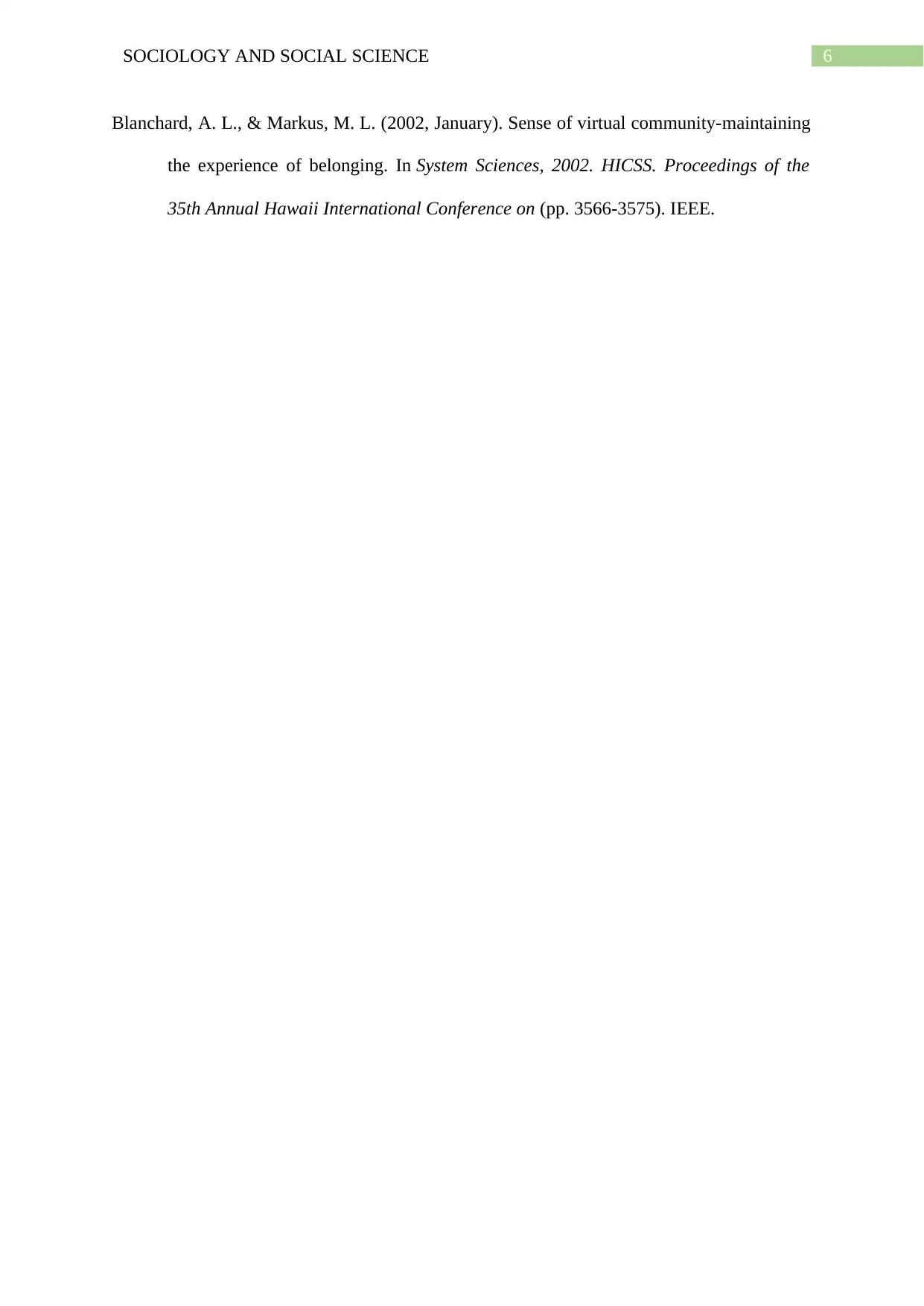
6SOCIOLOGY AND SOCIAL SCIENCE
Blanchard, A. L., & Markus, M. L. (2002, January). Sense of virtual community-maintaining
the experience of belonging. In System Sciences, 2002. HICSS. Proceedings of the
35th Annual Hawaii International Conference on (pp. 3566-3575). IEEE.
Blanchard, A. L., & Markus, M. L. (2002, January). Sense of virtual community-maintaining
the experience of belonging. In System Sciences, 2002. HICSS. Proceedings of the
35th Annual Hawaii International Conference on (pp. 3566-3575). IEEE.
1 out of 7
Related Documents
Your All-in-One AI-Powered Toolkit for Academic Success.
+13062052269
info@desklib.com
Available 24*7 on WhatsApp / Email
![[object Object]](/_next/static/media/star-bottom.7253800d.svg)
Unlock your academic potential
Copyright © 2020–2025 A2Z Services. All Rights Reserved. Developed and managed by ZUCOL.




